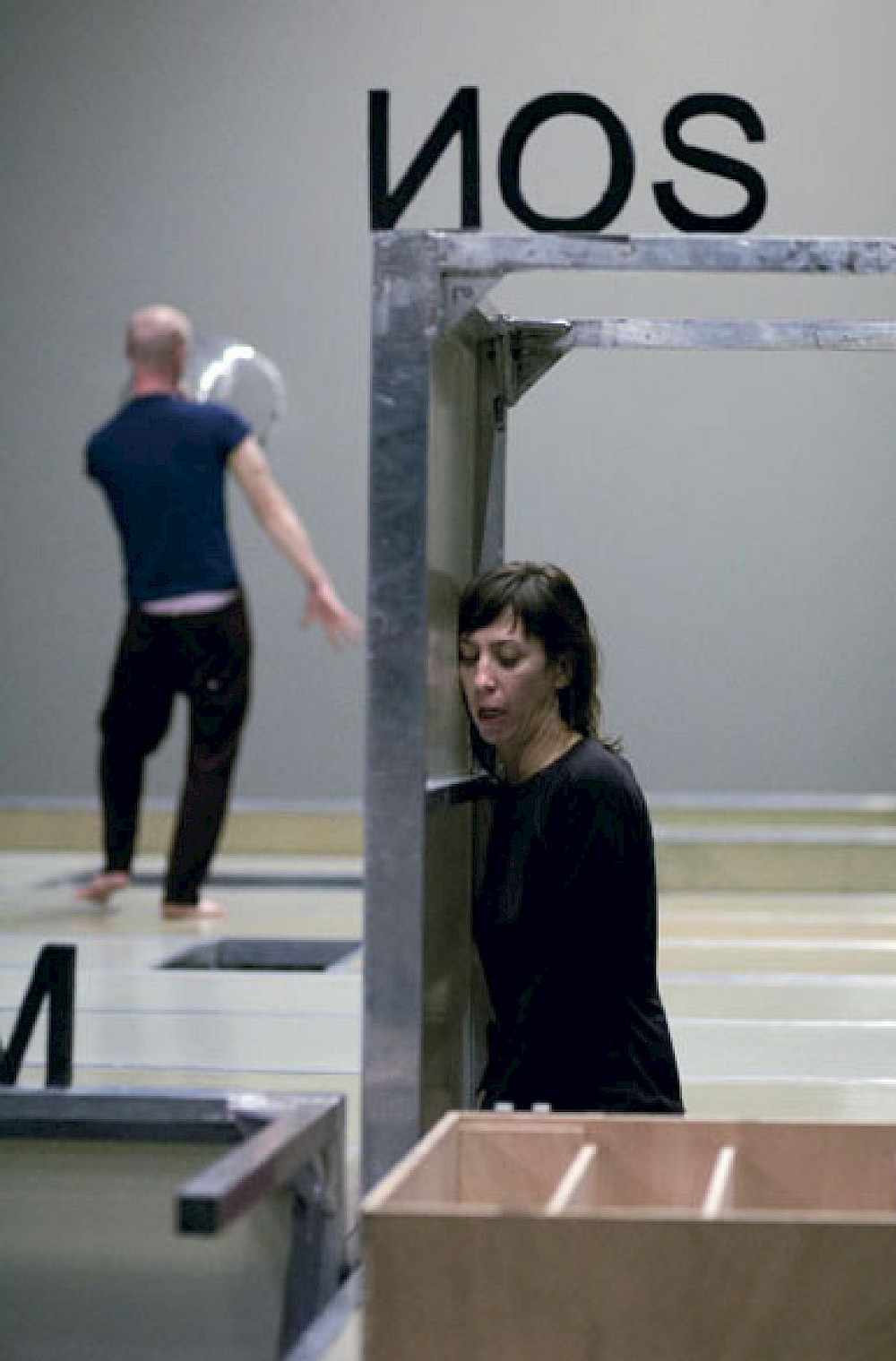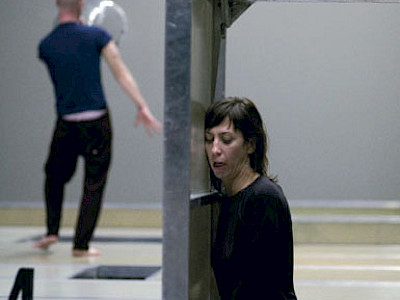13 — 15.05.2009
Heterotopia is a meditation on the nature of translation and the failures that attend its efforts. The work transpires in two obscure topographies of unarticulated desire. One, a raucous and supernatural oratorio, which is performed in incomprehensible yet intelligible languages, serves as a complementary orchestra to the other, a strange assembly of listening creatures, whose futile attempts to understand the perplexing music result in still stranger actions.
Spaces to Explore: Heterotopia by William Forsythe
by Gerald Siegmund
As the audience enters the performance space, they are met by a sea of tables that have almost become a fixture in William Forsythe’s recent pieces. Some of them are propped up like tombstones in a graveyard. From an impenetrable netherworld below the surface, dancers pop up unexpectedly through gaps in the arrangement to gesticulate wildly or to laugh maniacally. At one side, a dancer is constantly rearranging a series of letters into nonsensical words, while others simply walk across the tables, stop shortly to meet, and go on minding their own business. They seem to be completely absorbed in what they are doing, always finding new positions to operate from, and new possibilities to work the field that holds them like cogs in a machine. Somewhere a bowl with a microphone is lying around. A dancer picks it up and speaks into the microphone. The sound generated in this orchestra pit is transmitted to a second room, separated from the first one by a wall of thick curtains. Having lost their source, the sounds in the darker back room take on an eerie quality. There, the dancers listen, trying to pick up the noise and the static to perform strangely contorted duets. A piano is standing around, most of the time unused, as a warning sign of the ballet class that may have once taken place in there. The audience is free to wander about, sit down or change rooms whenever they see fit.
The title of Heterotopia, a “work” by William Forsythe, quotes Michel Foucault’s famous essay “Of Other Spaces”. Derived from two radio features in late 1966, the French philosopher reworked these programmes into a lecture that was first held in 1967 and first published as late as 1984, the year of Foucault’s death. In the essay, Foucault distinguishes between “utopias” which have no real place, and “heterotopias” which are real places within any given society. “There are also, probably in every culture, in every civilization, real places – places that do exist and that are formed in the very founding of society – which are something like counter-sites, a kind of effectively enacted utopia in which the real sites, all the other real sites that can be found within the culture, are simultaneously represented, contested, and inverted.” Like cemeteries, hospitals, sacred or subcultural places, they relate to all the other places in society in order to simultaneously represent, contest and invert their ways of functioning. For Foucault, the theatre is such a counter-site. It has the capacity to present different places on stage, either at the same time or successively. Like a library, it makes cuts through time to hold various times present at once. If any theatre piece can do this, what does a piece do that explicitly calls itself Heterotopia? Heterotopia by William Forsythe is, as I would like to suggest, the heterotopia of conventional theatre and dance pieces: it is the space where the ordinary ways of social interaction and the way they are represented in a theatrical context are questioned and explored.
Like Human Writes the year before and The Defenders the year after, Heterotopia was rehearsed and premiered in 2006 at the Schiffbau Theatre in Zurich, Switzerland: a huge open space that was once used for ship building. It has since been shown at the Festspielhaus in Dresden-Hellerau, the Montpellier Dance Festival, and the Bockenheimer Depot in Frankfurt am Main. Since his piece Decreation in 2003 that was based on an opera by Canadian writer Anne Carson, William Forsythe has repeatedly been interested in exploring the connection between sound and movement. Heterotopia, too, started off from observing the way movement travels through the body in order to affect the vocal chords. Positions of the body, however contorted or twisted they may be, will produce a certain sound as a direct result of working on the physicality of the body. If you took one of the letters standing on the tables in your mouth, how would that feel, and what kind of sound would it allow you to make? Movement and shapes are thus translated into sound that opens up an acoustic space that functions as the “other space” of the space you actually see. Sheep or goats bay and bray, birds twitter, bees hum, and melodies are intonated. The composer Thom Willems electronically reworks some of them and adds extra layers of musical elements to the live score. If you close your eyes, you can imagine lying on the grass somewhere in the countryside on a peaceful summer’s day. Some of the dancers speak in foreign languages that faithfully reproduce the intonation patterns of Russian or Spanish. Although they sound like Russian or Spanish, they are, in fact, artificial constructions. And yet, the audience cannot help thinking and feeling that they actually understand the highly articulate gibberish coming from the lips of the dancers.
According to Foucault’s definition, heterotopias are to be found everywhere in William Forsythe’s performance installation. Acoustic and visual spaces are split, separated and made to proliferate. The most obvious heterotopia is the two adjacent rooms: the busy white front room and the dark calm back room, the first a generator of sound, the second a receptacle of noises. Apart from that, the front room is divided in itself between a visible half above the tables and a labyrinth-like area below the tables that is not entirely visible to the audience. The acoustic space of the front room becomes the acoustic space of the back room, where it – together with the dancers and the room itself – creates an entirely different space. The dancers’ shapes are translated into sound that turns their bodies into heterotopias where humans become animals. Bodies inevitably take up space. That is why they are bodies. Although the body is highly topical, it has the capacity to imagine itself, as Foucault says, weightless or shapeless. It has the capacity to transcend its limits and to imagine itself as other, thereby giving itself another shape. The human body as such, therefore, is the site for heterotopias.
What is at stake, then, in Heterotopia is the possibility of human communication. In the series of heterotopic translations of one space into another space, all meaning gets lost. We are left adrift in a sea of seemingly random actions and sounds that strangely enough give the impression of coherence. Maybe this is simply the case because we want it to cohere. But the rawness of sound and action also triggers effects that travel from body to body, translating the dancers’ emotional spaces into the audience’s emotional states. Whereas feelings are highly subjective and in all their stickiness belong to one’s self, effects communicate. They are dialogical. Whereas traditional theatre and dance pieces bind these effects into story, character, or meaningful partnering, Heterotopia isolates them to inspect them. The piece therefore explores communication below the level of communication and unearths the capacity of language, sound and movement to create spaces for interaction before such a thing actually takes place. It functions as a gesture that opens up possibilities without settling for meaning or truths. It gives the audience spaces to explore.
By
William Forsythe
With
Yoko Ando, Cyril Baldy, Esther Balfe, Francesca Caroti, Amancio Gonzalez, David Kern, Ioannis Mantafounis, Fabrice Mazliah, Roberta Mosca, Tilman O‘Donnell, Nicole Peisl, Jone San Martin, Parvaneh Scharafali, Yasutake Shimaji, Elizabeth Waterhouse, Ander Zabala
Music
Thom Willems
Sound Design
Dietrich Krüger, Niels Lanz
Costumes
Dorothee Merg
Dramaturgy
Freya Vass-Rhee
Presentation
Les Halles de Schaerbeek, Kunstenfestivaldesarts
Production
The Forsythe Company
No admittance to children under the age of 12.
The Forsythe Company is supported by the city of Dresden and the state of Saxony as well as the city of Frankfurt am Main and the state of Hesse. The Forsythe Company would like to thank Susanne Klatten for her support. We would like to thank Ernst&Young for their support.


